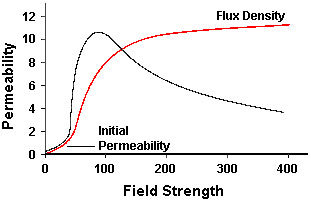With TJ Byers
Permeability Defined
Question:
The inductance of an inductor is given by L = µN2A / l
where
µ — Initial permeability of the core
N — Number of turns
A — Cross sectional area of the core
l — Core length
Now, what is the initial permeability? What is the difference between the initial permeability and the effective permeability? Why isn’t the average permeability of the hysteresis loop used in the calculation rather than the initial permeability?
M. John
Answer:
In a word: field strength. Actually, that’s two words, so let me explain. Permeability is the ability of a material to maintain a magnetic field (air has a permeability of 1) and is defined as the change in magnetic induction (B) for a given change in magnetic field (H). Mathematically, permeability is expressed as µ = ΔB / ΔH. As the magnetic field strength increases, so does the permeability — up to a point. When the material is magnetically saturated, permeability peaks, then begins a decline (Figure 1).

Initial permeability describes the permeability of a material at low values of B and may be listed in data sheets as absolute permeability. One definition of initial permeability is 3% of its maximum value. Relative
permeability is the ratio between the permeability of the material under test in relationship to the permeability of free space (vacuum) – µrelative = µmaterial / µfree space or µr = µ1/µ0. Effective permeability is often used for cores that have air gaps. This makes the calculations easier because you can ignore the gap by pretending that you are using a material whose permeability is lower than the material itself. Effective permeability is usually relative to initial permeability, and may be listed as average permeability.
Now that you’re totally confused, let’s assume you’re winding a balun coil. It’s very unlikely that you’re going to come close to saturating the core, so one must assume that the permeability is at its lowest — initial permeability. How much is that? Look to the next question (“Permeability Measured”).


Comments